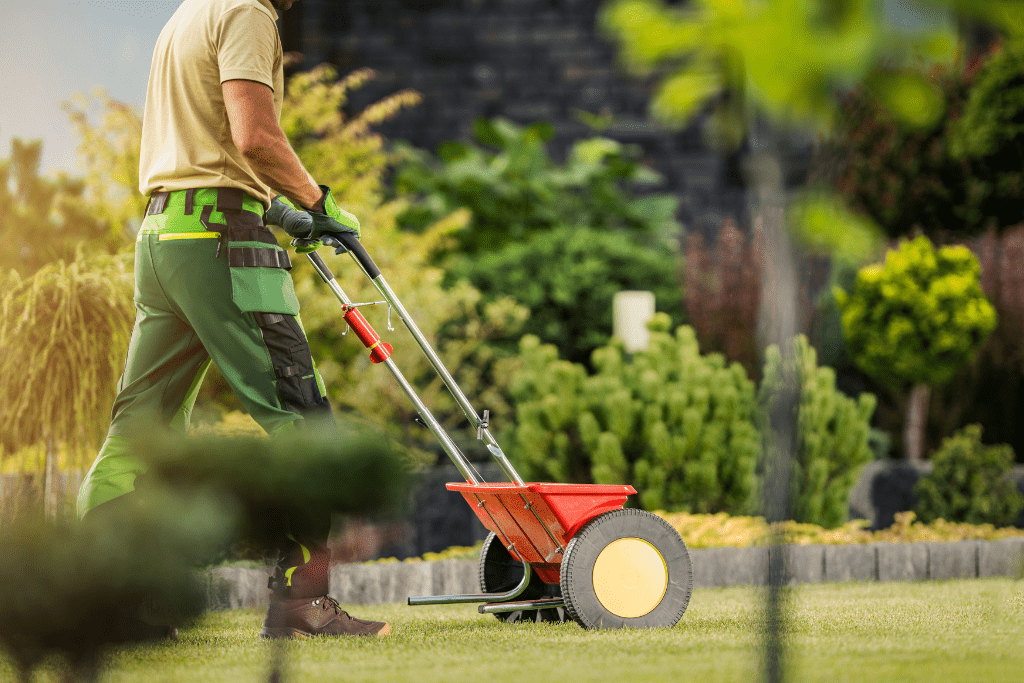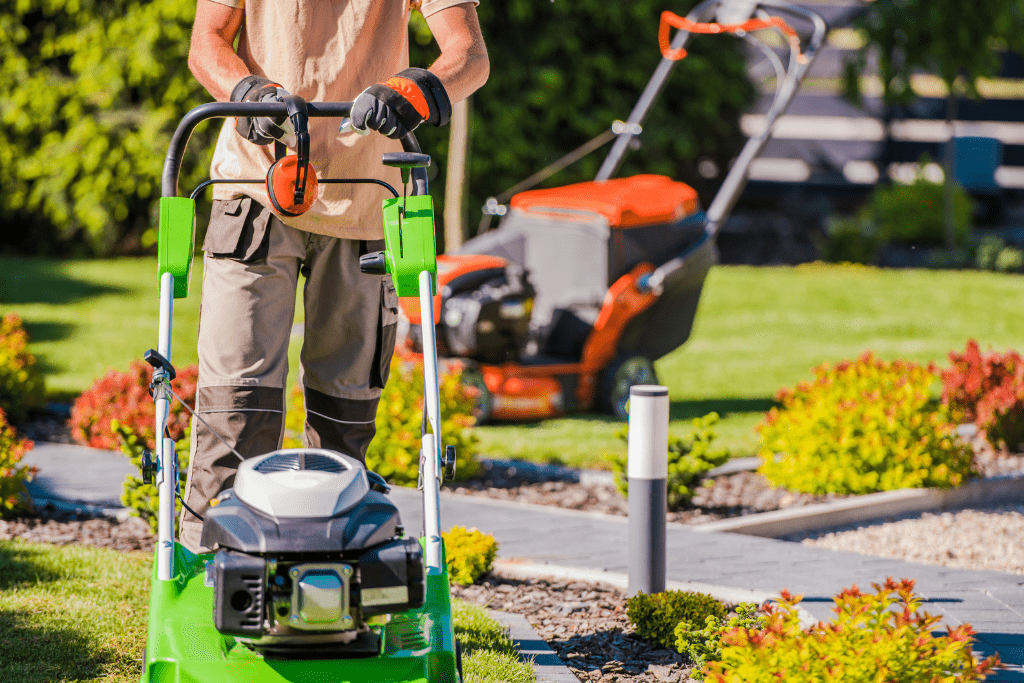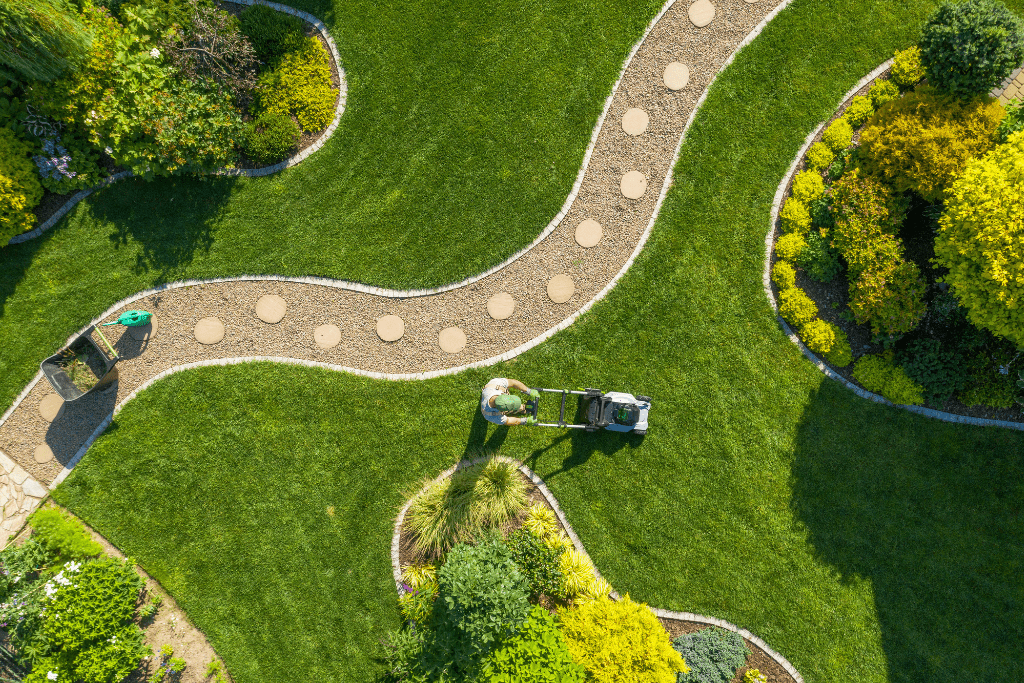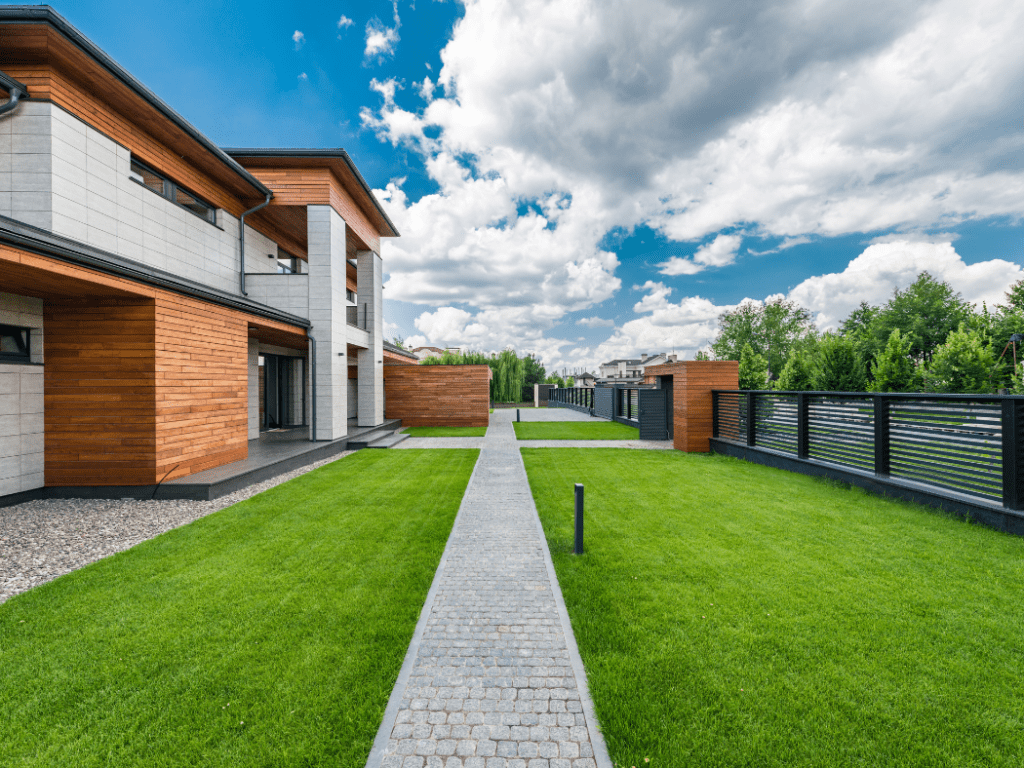Lawn aeration, though often overlooked, is a straightforward process with a profound impact on the health and beauty of your lawn. It’s the unsung hero in the quest for that perfect, eye-catching green space.
Everyone loves a sprawling, emerald-green lawn. It’s the verdant canvas on which memories are made and the idyllic backdrop for those sun-soaked Instagram moments.
Home is where the heart is, and a home’s intrinsic (and resale) value extends beyond its walls. Our outdoor spaces – particularly our lawns – contribute immensely to the happiness and comfort of our homes. A lush, vibrant lawn is not just a space; it’s an experience, a sanctuary, a memory-maker.
Imagine that soft green carpet under your bare feet, the backdrop to your family picnics, or the stage for your children’s imaginative play. A beautiful lawn is the unsung hero of countless cherished moments, from your early morning coffee in tranquility to the twilight games of catch on cool summer evenings.
But this patch of paradise doesn’t just appear out of thin air. It’s a labor of love, a testament to dedication and knowledge. Among the numerous tactics in the arsenal of gardening techniques, there’s one magic trick often overlooked but capable of turning the tides: lawn aeration.
Perhaps you’ve heard whispers about it in hushed gardener circles. Maybe you’ve seen the term “lawn aeration” floating around the internet. But what is it exactly? Why is it important? And, most importantly, how does it bring you one step closer to achieving your green dream?
Strap in, gardening fans; we’re about to embark on a verdant voyage of discovery. By the time we’re done, the enigma of lawn aeration will be a thing of the past. Ready?
What Is Lawn Aeration?
Let’s begin our exploration by answering the question: What is lawn aeration? In the simplest terms, lawn aeration is a process that creates small holes in the soil of your lawn. These holes, typically about two to six inches apart, give your lawn room to breathe and grow. But why does your lawn need a breather?

Imagine you’re in a room packed with people. It’s tough to move around, and the air becomes stifling after a while. You step outside, and suddenly, you can breathe freely. You feel refreshed, invigorated. This is precisely the kind of relief lawn aeration provides to your garden.
Over time, as your lawn sees foot traffic and natural wear, the soil becomes compacted. Just as you’d struggle to navigate a dense crowd, your lawn’s roots struggle to reach the air, water, and nutrients they need to grow. Compacted soil also restricts the growth of beneficial soil organisms, making your lawn less able to recover from damage or resist disease.
Aeration counters this by removing small ‘plugs’ or ‘cores’ of soil from your lawn. This process opens up the compacted soil, allowing air, water, and nutrients to reach the root zone more efficiently. In essence, lawn aeration improves soil circulation, enabling lawns to breathe, feed, and grow more efficiently.
These aeration holes also break up thatch – a layer of dead grass, roots, and debris that can accumulate on a lawn’s surface. A little thatch is fine, but too much can create a barrier, preventing essential elements from reaching the soil. By breaking up the thatch layer, aeration helps your lawn benefit from sunlight, water, and nutrients.
In a nutshell, lawn aeration is like giving your lawn a deep, refreshing breath, allowing it to thrive and maintain its vibrant, lush green charm. It’s a vital step in lawn care that, though often overlooked, can make a world of difference to the health and beauty of your outdoor sanctuary. It may seem like a simple process, but it holds the key to a flourishing, verdant lawn.
Why Is It Important to a Beautiful Garden?
Why is it so significant if lawn aeration is simply about punching holes in your soil? What role does it play in the grand scheme of lawn care? Let’s uncover the reasons behind the importance of lawn aeration for a healthy lawn and a beautiful garden.

- Root Growth and Lawn Health: A lawn is as healthy as its roots. When a lawn’s roots are restricted by compacted soil, it can struggle to access the nutrients, air, and water it needs to flourish. Aeration alleviates soil compaction and allows roots to expand and grow more robust. This results in a lawn that is not only more resistant to disease and pests but also better equipped to handle the heat of summer and cold of winter.
- Nutrient Absorption: Like us, lawns need a balanced diet to stay healthy. A lawn’s ‘food’ consists of the nutrients in the soil. When soil is compacted, these nutrients can’t reach the grass roots effectively. Aeration helps improve the delivery of vital nutrients to the roots, enhancing your lawn’s overall health and vitality.
- Water Management: A well-aerated lawn absorbs and retains water more effectively, reducing water run-off and promoting deeper root growth. This is not only great for your lawn’s health but also beneficial for your water bill and the environment.
- Thatch Control: As mentioned before, thatch is a layer of dead grass, roots, and other organic debris that can accumulate on the surface of your lawn. Too much thatch can be a barrier, preventing water, air, and nutrients from penetrating the soil. Aeration helps control thatch buildup, ensuring your lawn gets everything it needs to thrive.
- Aesthetics and Resilience: Last but not least, lawn aeration contributes to your garden’s overall aesthetics and resilience. A well-aerated lawn is typically denser, greener, and more robust, capable of standing up to the rigors of daily use and looking good. A healthy lawn can enhance your garden’s overall appeal, adding to your home’s beauty.
In essence, lawn aeration is the unsung hero in your lawn care routine, working behind the scenes to ensure your green space stays lush, vibrant, and healthy. It’s like your lawn’s personal trainer, helping it to grow stronger, perform better, and look its best. By giving your lawn the breath of fresh air it needs, aeration sets the stage for a garden that looks beautiful but is also robust and healthy from the ground up.
How Does Lawn Aeration Work?
During lawn aeration, hundreds of small holes are put into the soil, which makes it easier for the elements to make it into the grasses roots. Some lawn aeration methods include making smaller slices in the yard or removing pieces of the soil. Lawn aeration also helps prevent soil compaction, which makes it difficult for water and other important nutrients to get into the roots. With access to more nutrients, the grass can grow better, leaving you a vibrant, lush yard.

Lawn aeration services are especially beneficial on thickly compacted grasses. This may include areas with heavy foot traffic or soil. However, even if you don’t have heavy soil, most lawns will benefit from lawn aeration.
When Should You Aerate Your Lawn?
Knowing what lawn aeration is and why it’s important is half the battle. The other half? Timing it right. So, let’s tackle the pressing question: When should you aerate your lawn?
Lawn aeration is not a year-round activity but a seasonal task. The best time to aerate your lawn largely depends on your grass type. Lawns generally fall into two categories: cool-season grasses and warm-season grasses, each having its ideal time for aeration.
It’s best to aerate your lawn when it’s slightly moist. Lawn care professionals typically recommend watering your lawn at least a few days before aeration. Of course, you also want to avoid over-watering, as this can further compact the soil. You should, however, avoid lawn aeration when the soil is wet.
- Cool-Season Grasses: If you have cool-season grasses like Kentucky bluegrass or ryegrass, the best time to aerate your lawn is during the growth spurts in the spring and fall. Aeration during these periods allows the grass to heal and fill any open areas after removing soil plugs.
- Warm-Season Grasses: For warm-season grasses like Bermuda grass or Zoysia, late spring to early summer is the best time to aerate. Aerating the lawn during this period ensures quick recovery as the warm-season grasses grow most vigorously in this timeframe.
Regardless of your lawn type, a good rule of thumb is to aerate when your grass is in its peak growing season. That way, it can recover quickly, filling the areas where the lawn aerators have exposed the soil.
Another timing factor is related to overseeding, which often goes hand in hand with lawn aerating. If you plan to aerate and overseed, the best time is usually early fall for cool-season grasses and late spring for warm-season grasses. Aeration opens up the soil, providing the seeds easier access and better soil contact, leading to improved germination rates.
Remember, when it comes to lawn aeration, timing is everything. Just like baking a chocolate cheesecake or planting a flower, get the timing right, and you’re halfway there. A well-timed aeration session can mean the difference between a good lawn and a great one. So keep an eye on the calendar, your lawn, the weather, and your garden will thank you.
How Often Should You Aerate Your Lawn?
Now that we know when in the year to aerate the lawn, another question arises: How often should you aerate your lawn? The frequency of lawn aeration can significantly influence the health and appearance of your green spaces, so let’s unravel this mystery.
The frequency of lawn aeration depends largely on the type of soil and the amount of use your lawn gets. Most lawns are content with yearly aeration sessions, but let’s dig deeper.
- Clay Soils: Lawns with clay soils often benefit from aeration twice a year – once in the spring and once in the fall. Clay soil tends to compact more quickly than other soil types, necessitating more frequent aeration.
- Sandy Soils: If you have sandy soil, your lawn probably drains well and therefore doesn’t compact as quickly as clay soil. In this case, you can aerate your lawn once a year or even once every two years.
- High-Traffic Lawns: Your lawn’s foot traffic can also determine how often to aerate. If you have kids or pets that frequently run on the lawn or serve as the stage for backyard parties, you may need to aerate your lawn twice a year. The added foot traffic can lead to compaction, which lawn aeration can help alleviate.
- Newly Established or Severely Neglected Lawns: If your lawn is newly seeded or sodded or has been neglected for several years, more frequent aeration in the first couple of years can hasten its journey to peak health and beauty.
- Overseeding: If you plan to overseed your lawn, you’ll want to aerate right before doing so. The open soil provides a great spot for the new seeds to take root. Typically, you’ll overseed cool-season grasses in early fall and warm-season grasses in late spring.
Remember, it’s possible to aerate your lawn too much. Over-aerating can lead to a rough lawn surface and stress the grass. So, while it’s important to aerate regularly, try not to overdo it.

In essence, there is no one-size-fits-all answer when it comes to how often to aerate your lawn. Every lawn is unique, and its aeration needs can change based on various factors. Consider your lawn’s soil type, usage, and the overall health of the grass. Then, tune into your lawn’s needs, adjust your aeration frequency accordingly, and you’ll be well on your way to maintaining a lush, vibrant lawn that’s the envy of the neighborhood.
Understanding the Dangers of Lawn Aeration
Lawn aeration is a fantastic tool in a gardener’s arsenal. It promotes healthy grass growth, improves water and nutrient absorption, and helps manage thatch. But like any tool, it can pose certain dangers if not used properly. Let’s delve into some potential risks of lawn aeration.
- Over-Aeration: More is not always better, and this is especially true for lawn aeration. Over-aerating your lawn can stress the grass and result in a rough, uneven lawn surface. It’s crucial to follow the right aeration frequency based on the type of soil and usage of your lawn to avoid such issues.
- Wrong Timing: Aerating at the wrong time can harm your lawn. If you aerate warm-season grasses in the fall or cool-season grasses in the summer, the grass might not have enough time to recover before going into a dormant or stress period.
- Damage to Underground Utilities: Lawn aerators are designed to penetrate the soil, but sometimes they might encounter more than just soil. Underground utility lines for electricity, water, or gas can be damaged during the aeration process if they are not correctly marked or are too close to the surface. It’s important to know the location of these utilities before you start aerating.
- Neglecting Aftercare: Aeration is a stressor for your lawn. If the lawn is not properly watered and fertilized after aeration, it can lead to a weak and unhealthy lawn. Aftercare is a crucial step in the aeration process to help the lawn recover and make the most of the aeration benefits.
- Disease and Pests: Aeration creates holes in the lawn, which lawn diseases and pests can sometimes use as an entry point. If your lawn is already dealing with such issues, it might be better to address them before proceeding with aeration.
- Weed Spread: Aeration can inadvertently help weed seeds get into the soil and germinate. To mitigate this risk, consider combining aeration with overseeding and proper lawn maintenance to encourage the growth of grass instead of weeds.
While these dangers exist, they shouldn’t deter you from aerating your lawn. With the right knowledge and precautions, the risks can be effectively managed, allowing you to reap the substantial benefits of lawn aeration. It’s about using this powerful tool judiciously and responsibly, not avoiding it altogether. Remember, the goal of lawn aeration, like any other aspect of lawn care, is to help your lawn reach its full potential.
Benefits of Professional Lawn Aeration
There are many benefits to outsourcing your lawn aeration services to a professional, including the following:
Less Chance of Yard Damage
Aerating too frequently can damage your soil and oversaturate your grassroots. This can eventually damage your grass and prevent it from growing. You could also waste money and time on seeding if you don’t time your lawn aeration properly. Waiting to apply fertilization until after lawn aeration also prevents it from compacting your soil too tightly.
Personalized Service
No two lawns are the same. Working with a professional means, you’ll receive an aeration plan customized to your lawn and landscaping goals. Some grass types, for example, may require more seeding or nutrients. Your professional lawn aeration company will create a service plan that achieves your dream lawn. Your lawn may simply need small holes to let some air and nutrients in, or it may need plugs of soil and grass removed to allow deeper penetration.

Better Results
You’re also likely to notice better results when outsourcing aeration services. A common problem DIY landscapers make is making the aeration holes too big. While you should leave the grass plugs in the yard, you don’t want to make the holes so big that they fall back in and block nutrients. Seeding is best paired with lawn aeration services. Professionals can carefully time this process, ensuring your lawn receives what it needs when it needs it. You can even boost your home’s curb appeal with lawn care and aeration services.
Careful Timing
Successful aeration requires careful timing. Aerating too near the seeding process can limit its benefits. Additionally, avoiding aeration following excessive heat or a strong storm is usually best, as it can worsen lawn damage. Ideally, you’ll want to complete lawn aeration at least once per year. However, some lawns may require less frequent lawn aeration, which is another good reason to work with a professional.
The best timing for lawn aeration also depends on the type of grass. For example, cool-season grasses are best aerated outside of the summer months. Warm-season grasses show the best results in early summer.
| DIY Lawn Aeration | Professional Lawn Aeration Service | |
| Cost | More cost-effective as you’ll only need to rent or buy a lawn aerator. | More expensive as you’re paying for both labor and equipment use. |
| Time and Effort | Requires time, physical effort, and some lawn care knowledge. | Time-saving and less physically demanding as the professionals handle everything. |
| Quality | Quality of aeration may vary based on your skill and the quality of the rented or purchased aerator. | Generally high quality due to professional skills and commercial-grade equipment. |
| Knowledge | Requires understanding of when and how to aerate, as well as dealing with any arising issues. | Professionals know to determine the best time to aerate and how to handle potential issues. |
| Risk Management | Risks like damaging underground utilities or over-aerating are higher if you lack experience. | Lower risk as professionals are experienced and often insured against damage. |
| Maintenance Advice | You’ll need to research or seek advice for post-aeration care. | Professionals can provide expert advice on lawn maintenance and post-aeration care. |
| Flexibility | You can aerate at your convenience and as frequently as your lawn requires. | Scheduling depends on the service provider’s availability. |
| Tools Storage | If you purchase a lawn aerator, you’ll need space to store it. | No need for tool storage as the service provider brings and takes away the equipment. |
| Environmental Impact | DIY allows you to control the environmental impact, such as deciding not to use gas-powered tools. | It depends on the practices of the professional service, which you may not have control over. |
Remember, choosing DIY lawn aeration and hiring a professional service depends on your budget, time, physical ability, and interest in lawn care. There’s no right or wrong answer, only what works best for you and your lawn.
Regenerate response
What to Expect – Lawn Aeration
The length of the lawn aeration process varies, depending on the size of your lawn, your grass type, and your lawn’s unique needs. You should water your lawn after aeration, taking care to avoid oversaturating the lawn. Let the grass grow at least three inches before mowing again. It’s also best to avoid too much movement on the lawn for a few weeks, which could lead to compacted soil holes. This means keeping pedestrians, children, and pets off the yard. Most people will notice results from professional lawn aeration within six to eight weeks. However, your lawn should begin germination within two to four weeks.

Lawn aeration offers many benefits if done correctly and at the right time. Removing small parts of your lawn ensures a direct flow of water and nutrients, allowing you to enjoy a beautiful, healthy lawn.
Summary and Key Takeaways: The A to Z of Lawn Aeration
Well, we’ve taken quite a journey together through the world of lawn aeration! It’s time now to pause and reflect on the key takeaways from this comprehensive guide to aerating your lawn.
- Understanding Lawn Aeration: Lawn aeration is a process that creates small holes in the soil to allow air, water, and nutrients to penetrate grass roots. This helps the roots grow deeply, resulting in a healthier lawn.
- The Importance of Lawn Aeration: Aerating your lawn is vital for a healthy lawn and beautiful garden. It fights soil compaction, enhances water and nutrient uptake, boosts oxygen levels, aids thatch breakdown, and promotes root growth.
- When to Aerate Your Lawn: The timing of lawn aeration is crucial. Generally, you should aerate your lawn during its peak growth period. That’s early spring or fall for cool-season grasses, while warm-season grasses do best with aeration in late spring or early summer.
- Frequency of Aeration: The frequency of lawn aeration depends on various factors, including your lawn’s soil type and usage. Clay soils and high-traffic lawns may benefit from being aerated twice a year, while sandy soils might only require aeration once every one to two years.
- Potential Dangers of Lawn Aeration: Despite its numerous benefits, lawn aeration can pose risks if not executed correctly. These include over-aeration, wrong timing, damage to underground utilities, and neglecting aftercare.
- DIY vs. Professional Services: Whether you choose to DIY or hire a professional lawn aeration service depends on factors like cost, time, effort, knowledge, and convenience. Both options have their pros and cons.

Lawn aeration, whether done by a homeowner or a professional, is crucial to maintaining a lush and vibrant lawn. It’s an investment of time and resources that pays off by providing a healthy, green lawn that’s a sight for sore eyes and a source of pride. After all, nothing quite beats the satisfaction of looking out your window and seeing a lawn brimming with life, thanks to your hard work and care!Aerate that lawn, let it breathe, mix in some coffee grounds, and watch it flourish. It’s time to give your lawn the love it deserves.

